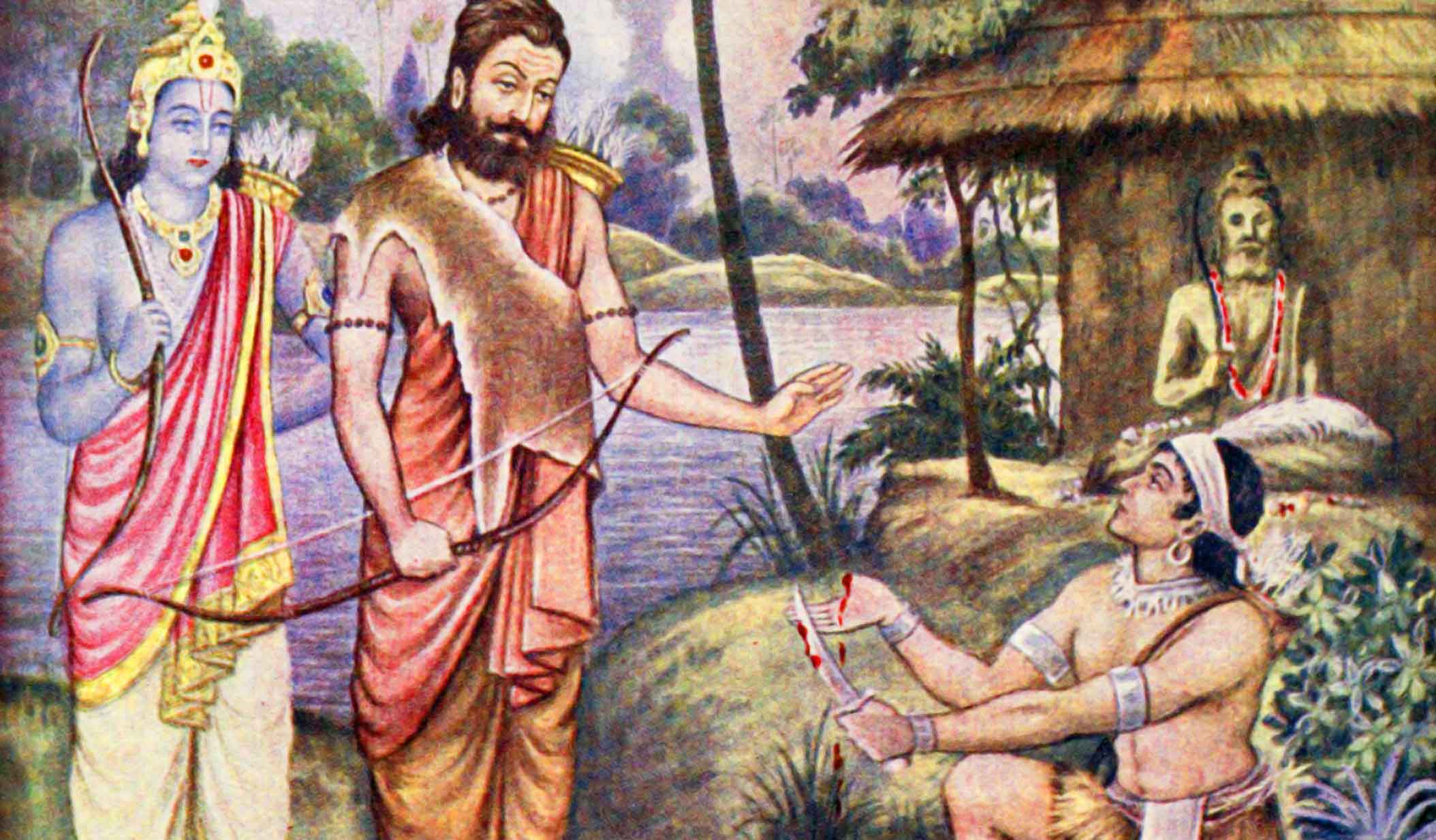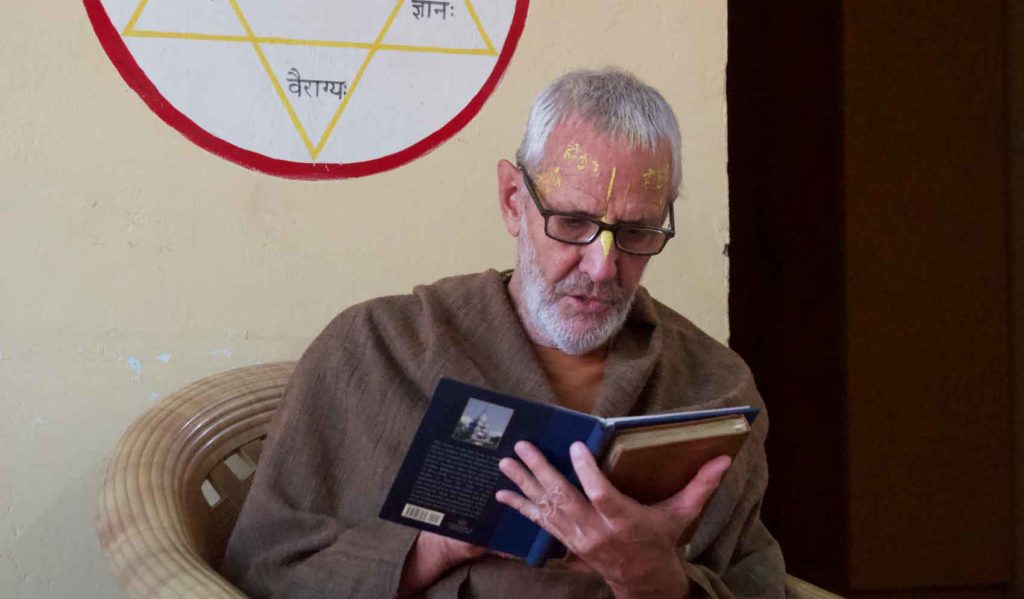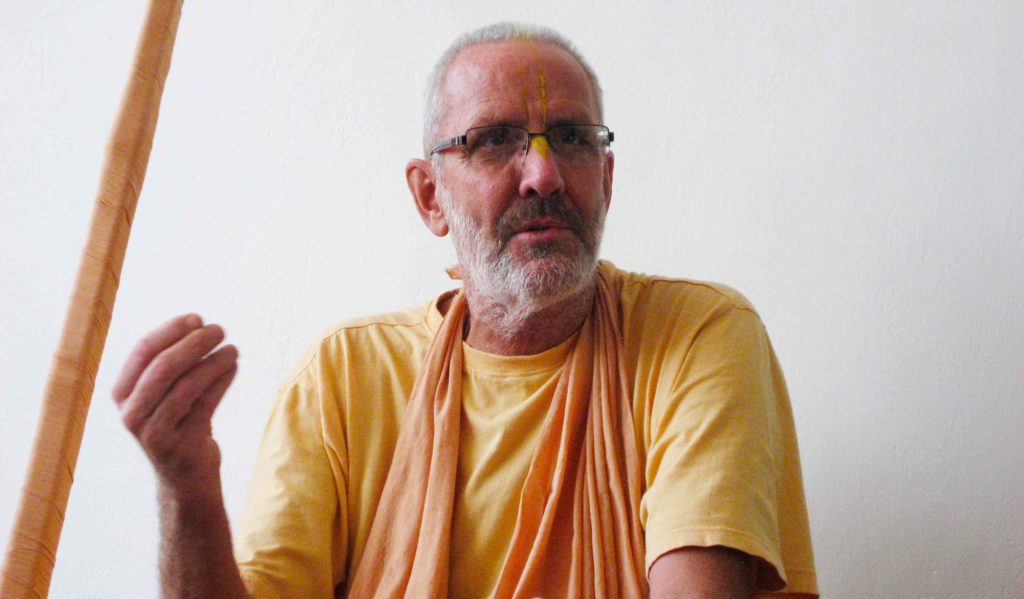Overview
In this article, Śrīla Sarasvatī Ṭhākura tells the story of Ekalavya and explains how his so-called guru-bhakti to Droṇācārya was nothing but pride. This article was translated from Upakhyāne Upadeśa, Vol. 2 by Swami B.V. Giri.
Many people consider Ekalavya’s ‘guru-bhakti’ to be ideal, but there is a unique deliberation concerning this topic.
King Hiraṇyadhanu’s son was named Ekalavya. Ekalavya was, by caste, a niṣadha (caṇḍāla). In order to learn astra-vidyā, Prince Ekalavya approached Droṇācārya. Because Ekalavya possessed a low class mentality, the ācārya refused to initiate him in the teachings of the Dhanur-Veda. However, Ekalavya was determined to learn the martial arts from Droṇācārya and went off into the forest. There he constructed an idol of Droṇācārya made of clay and by continuously practicing in front of that artificial guru he became very expert in astra-vidyā.
Arjuna was Droṇācārya’s most beloved disciple. The ācārya had told Arjuna that none of Droṇācārya’s disciples would ever be able to excel Arjuna in skill.
One day Droṇācārya instructed the Kauravas and the Pāṇḍavas to leave the royal capital and go to the forest for hunting. As they made their way through the forest, they saw a dog whose mouth had been blocked with seven arrows. Seeing this, they were most astonished. Whoever had shot these arrows was far more expert than the Pāṇḍavas. Realising this, they went in search of that person. Gradually they understood that it was Ekalavya, the son of Hiraṇyadhanu, who had tested his archery skills on the dog’s mouth.
The Pāṇḍavas returned to the capital and, approaching Droṇācārya, submitted this unusual story to him. With a mood of humility, Arjuna told Droṇācārya that it seemed that he had another disciple who was more expert in archery than Arjuna. Droṇācārya listened to these words and was surprised. He went with Arjuna into the forest and there they saw Ekalavya continuously shooting arrows like rain, fully absorbed in the science of archery.
Taking the opportunity Droṇācārya came forward and approached Ekalavya, and seeing the ācārya, Ekalavya immediately offered his prayers at his feet, and with folded hands he introduced himself as his disciple and remained standing. Droṇācārya told Ekalavya, “You must give guru-dakṣiṇā.”
Ekalavya replied, “Please tell me – whatever it is, I am ready to give it!”
Then Droṇācārya told Ekalavya to cut off his thumb and give him that as his guru-dakṣiṇā. Ekalavya executed the order of his Gurudeva. Ekalavya did not protest in any way and unhesitatingly executed his guru’s instruction.
Initially Ekalavya’s guru rejected him because he considered him to be born of a low caste, yet due to his faith in Droṇācārya, he established a clay deity of him and became invincible – thus his guru-bhakti was established as ideal. On the other hand, Arjuna was envious towards Ekalavya, because by his perseverance, Ekalavya had become expert; therefore Ekalavya was ruined by Droṇācārya – this is the common opinion.
But this is not the opinion of the devotees, nor is it a true conception. Everything about Bhagavān is supremely true, everything about the principles of devotion are supremely true and everything in relation to the devotee is supremely true. These are the three truths – Bhagavān, bhakti and bhakta. Everything a devotee does is good; everything a non-devotee does is not very good. The non-devotee has many bad qualities because he is not engaged in satisfying the senses of Bhagavān. Those that think that mundane laws are greater than Bhagavān cannot accommodate those words regarding the supreme truth. Such persons are nirviśeṣavādīs (impersonalists) which is to say that they cannot accept the non-differentiated specialty of Bhagavān, bhakti and bhakta.
What was Ekalavya’s fault? This analysis is essential. He wore the mask of guru-bhakti, yet he was actually inimical towards his guru. Whether his guru actually considered Ekalavya to be disqualified by his low-birth, or was simply testing him — whatever the reason may be, when his Gurudeva did not wish to teach him the science of warfare, it was Ekalavya’s duty to accept his guru’s instruction upon his head; but Ekalavya did not accept that. He had the aspiration to become great.
Externally, without a guru, his practices would not have been considered lawful, or he would not be in a favourable position to become great without accepting a guru. To this end, Ekalavya concocted a clay form of his ‘guru’. He only did this to attain greatness by learning the Dhanur Veda. In this way, his main intention was to satisfy his own senses. He did not offer himself as a sacrifice to his guru’s desire and his own intentions were not sincere. Some may say that ultimately Ekalavya happily accepted the heartless order of his guru without protest, but if we consider this topic deeply and with keen discernment, we can observe that Ekalavya considered mundane morality to be superior to transcendental devotion. When the guru requests something to be given as dakṣiṇā, then one must offer it to him – it was that sense of morality that inspired him to cut off his thumb. Ekalavya did not offer it with spontaneous devotion. The very nature of bhakti is that it is spontaneous and simple.
If Ekalavya had unmotivated and natural devotion within his heart towards Hari, Guru and Vaiṣṇava, then the guru, Droṇācārya, the best of Vaiṣṇavas, Arjuna, and Bhagavān Sri Kṛṣṇa, would not have been displeased with his behaviour. Ekalavya’s attempt to learn the Dhanur-veda and his hankering to become great were not accepted by his Gurudeva. Deep within Ekalavya’s heart, he desired to try and become greater than Arjuna, the best of Vaiṣṇavas. The aspiration to become greater than the Vaiṣṇavas is not devotion – it is anti-devotional and it is the dharma of the ativāḍīs (1). According to worldly considerations, the desire to become great is regarded as good. But the effort to take a subordinate position behind a Vaiṣṇava and the attempt to take shelter of a Vaiṣṇava – that is bhakti.
Ekalavya wanted his expertise to be greater than that which could be acquired by learning Vedic sciences directly from a mahant-guru – Arjuna notified Droṇācārya of this. If Arjuna had not mercifully pointed this out, then the victory of impersonalism would have been proclaimed extensively. People would not have approached a mahant-guru to accept any type of knowledge; they would have desired to create their own contradictory, concocted, clay, lifeless gurus in order to learn various sciences or devotional teachings. In this way, atheistic theories would have been established. Therefore, Arjuna had no envy towards Ekalavya; it was actually his causeless compassion towards Ekalavya and the world.
If Ekalavya had been an honest devotee of his guru, then Kṛṣṇa would not have killed such a guru-bhakta – He always protects His devotees. But finally Ekalavya was killed by the hand of Kṛṣṇa. This is how Ekalavya finally met his end (2).
Sri Caitanyadeva has said that we cannot judge devotion simply on the basis of external austerities. The asuras perform penances that even the demigods cannot perform (3). Against the wishes of his guru, Ekalavya wanted to become greater than the Vaiṣṇava. Therefore he was killed by Kṛṣṇa and attained impersonal liberation. Asuras are always killed by Kṛṣṇa and the devotees of the Lord are protected by Kṛṣṇa (4). The proof of this is Hiraṇyakaśipu and Prahlāda. Thus we should never attempt to become greater than the Vaiṣṇavas. If we do not wear a mask of guru-bhakti, we will never become impersonalists. This is what the pure devotees have taught in relation to the narrative of Ekalavya. Expertise in performing mundane activities is not guru-bhakti. Taking shelter of the Vaiṣṇavas is actually true devotion.
FOOTNOTES:
(1) The ativāḍīs are an apa-sampradāya that originated in Orissa under one Jagannātha Dāsa during the time of Mahaprabhu. The word ‘ativāḍī‘ means ‘one who thinks he is very intelligent’ (ati – very, vāḍī – intelligent).
(2) Ekalavya’s demise is found in Chapter 48 of the Udyoga-parva of Mahābhārata wherein Kṛṣṇa kills him as He battles with Jarāsandha’s army.
(3) asure o tapa kare, ki haya tāhāra
vine mora śaraṇa laile nāhi pāra (Cb. Madhya 23.46)
(4) Madhvācārya, in his Mahābhārata Tataparya Nirṇaya has commented that Ekalavya was the aṁśa of the demon Maṇimanta.
yuddhvā ciraṁ raṇa mukhe bhagavat sutaḥ asau
cakre nirāyudham amuṁ sthiram ekalavyam
aṁśena yo bhuvam agāt maṇimān iti sma
sa krodha tantraka gaṇeṣu adhipo niṣādaḥ
“Fighting for a long time with Ekalavya, who was steadfast in battlefield, Pradyumna rendered him weaponless. Previously there was a group of demons known as the Krodha-tantra-gaṇas, amongst whom there was a prominent demon named Maṇimanta. Ekalavya is the aṁśa of that Maṇimanta.” (MTN 14.40)
Related Articles
- Guru is One by Śrīla Bhakti Gaurava Narasiṅgha Mahārāja
- Omniscience? by Śrīla Bhakti Gaurava Narasiṅgha Mahārāja
- Paramparā by Śrīla Bhakti Gaurava Narasiṅgha Mahārāja
- The Vision of Guru by Śrīla Bhakti Gaurava Narasiṅgha Mahārāja
- Ekalavya and Arjuna by Śrīla Bhaktisiddhānta Sarasvatī Ṭhākura
- Can the Guru Make Mistakes? by Śrīla Bhakti Gaurava Narasiṅgha Mahārāja
- The Post of Guru by Śrīla Bhakti Gaurava Narasiṅgha Mahārāja
- The Compassionate Nature of Śrī Guru by Śrīla Bhakti Kiśora Āraṇya Mahārāja
- Is a Guru Necessary? by Gaura Gopāla Dāsa
Prema Dhāma Deva Stotram with the Narasiṅgha Sevaka Commentary – Verses 61-65
In verses 61 to 65 of 'Prema Dhāma Deva Stotram', Śrīla Śrīdhara Mahārāja narrates the pastime of Śrī Caitanya at Caṭaka Parvata In Purī and explains how the scriptures produced by Brahmā and Śiva are ultimately searching for the personality of Mahāprabhu who is merciful too all jīvas, no matter what their social position.
Prabhupāda Śrīla Sarasvatī Ṭhākura’s Visit to Ayodhyā
With the forthcoming observance of Śrī Rāma Navamī, we present 'Prabhupāda Śrīla Sarasvatī Ṭhākura’s Visit to Ayodhyā' written by Śrīla Bhaktisiddhānta Sarasvatī Ṭhākura Prabhupāda from The Gaudīyā magazine, Vol 3. Issue 21/ In December 1924, after visiting Benares and Prāyāga, Sarasvatī Ṭhākura visited the birth-site of Śrī Rāmācandra in Ayodhyā.
Śaraṇāgati – The Only Path to Auspiciousness
In this article, 'Śaraṇāgati - The Only Path to Auspiciousness', Dhīra Lalitā Dāsī analyses the process of śaraṇāgati (surrender) beginning with śraddhā (faith). She also discusses the role of śāstra and the Vaiṣṇava in connection with surrender.
Ātma Samīkṣā – The Value of Introspection
In this article, "Ātma Samīkṣā – The Value of Introspection" Kalki Dāsa highlights the importance of introspection in the life of a devotee and especially in relation to the worldly environment that surrounds us. He also explains how transcendental sound influences our capacity to introspect.
Prema Dhāma Deva Stotram with the Narasiṅgha Sevaka Commentary – Verses 61-65
In verses 61 to 65 of 'Prema Dhāma Deva Stotram', Śrīla Śrīdhara Mahārāja narrates the pastime of Śrī Caitanya at Caṭaka Parvata In Purī and explains how the scriptures produced by Brahmā and Śiva are ultimately searching for the personality of Mahāprabhu who is merciful too all jīvas, no matter what their social position.
Prabhupāda Śrīla Sarasvatī Ṭhākura’s Visit to Ayodhyā
With the forthcoming observance of Śrī Rāma Navamī, we present 'Prabhupāda Śrīla Sarasvatī Ṭhākura’s Visit to Ayodhyā' written by Śrīla Bhaktisiddhānta Sarasvatī Ṭhākura Prabhupāda from The Gaudīyā magazine, Vol 3. Issue 21/ In December 1924, after visiting Benares and Prāyāga, Sarasvatī Ṭhākura visited the birth-site of Śrī Rāmācandra in Ayodhyā.
Śaraṇāgati – The Only Path to Auspiciousness
In this article, 'Śaraṇāgati - The Only Path to Auspiciousness', Dhīra Lalitā Dāsī analyses the process of śaraṇāgati (surrender) beginning with śraddhā (faith). She also discusses the role of śāstra and the Vaiṣṇava in connection with surrender.
Ātma Samīkṣā – The Value of Introspection
In this article, "Ātma Samīkṣā – The Value of Introspection" Kalki Dāsa highlights the importance of introspection in the life of a devotee and especially in relation to the worldly environment that surrounds us. He also explains how transcendental sound influences our capacity to introspect.








